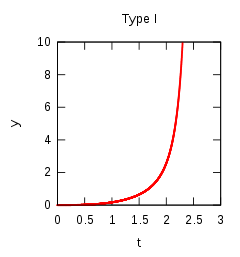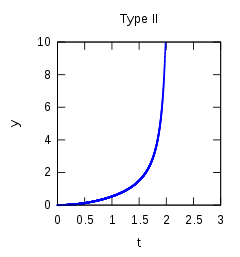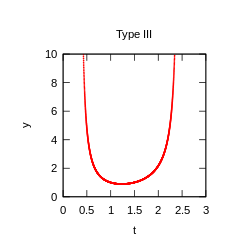Painlevé transcendents
In mathematics, Painlevé transcendents are solutions to certain nonlinear second-order ordinary differential equations in the complex plane with the Painlevé property (the only movable singularities are poles), but which are not generally solvable in terms of elementary functions. They were discovered by Paul Painlevé (1900, 1902), who later became the French prime minister.
History
Painlevé transcendents have their origin in the study of special functions, which often arise as solutions of differential equations, as well as in the study of isomonodromic deformations of linear differential equations. One of the most useful classes of special functions are the elliptic functions. They are defined by second order ordinary differential equations whose singularities have the Painlevé property: the only movable singularities are poles. This property is rare in nonlinear equations. Poincaré and L. Fuchs showed that any first order equation with the Painlevé property can be transformed into the Weierstrass equation or the Riccati equation, which can all be solved explicitly in terms of integration and previously known special functions. Émile Picard pointed out that for orders greater than 1, movable essential singularities can occur, and tried and failed to find new examples with the Painlevé property. (For orders greater than 2 the solutions can have moving natural boundaries.) Around 1900, Paul Painlevé studied second order differential equations with no movable singularities. He found that up to certain transformations, every such equation of the form
(with R a rational function) can be put into one of fifty canonical forms (listed in (Ince 1956)). Painlevé (1900, 1902) found that forty-four of the fifty equations are reducible in the sense that they can be solved in terms of previously known functions, leaving just six equations requiring the introduction of new special functions to solve them. (There were some computational errors in his work, which were fixed by B. Gambier and R. Fuchs.) It was a controversial open problem for many years to show that these six equations really were irreducible for generic values of the parameters (they are sometimes reducible for special parameter values; see below), but this was finally proved by Nishioka (1988) and Hiroshi Umemura (1989). These six second order nonlinear differential equations are called the Painlevé equations and their solutions are called the Painlevé transcendents.
The most general form of the sixth equation was missed by Painlevé, but was discovered in 1905 by Richard Fuchs (son of Lazarus Fuchs), as the differential equation satisfied by the singularity of a second order Fuchsian equation with 4 regular singular points on P1 under monodromy-preserving deformations. It was added to Painlevé's list by Gambier (1910).
Chazy (1910, 1911) tried to extend Painlevé's work to higher order equations, finding some third order equations with the Painlevé property.
List of Painlevé equations



These six equations, traditionally called Painlevé I-VI, are as follows:
- I (Painlevé):
- II (Painlevé):
- III (Painlevé):
- IV (Gambier):
- V (Gambier):
- VI (R. Fuchs):
The numbers α, β, γ, δ are complex constants. By rescaling y and t one can choose two of the parameters for type III, and one of the parameters for type V, so these types really have only 2 and 3 independent parameters.
Singularities
The singularities of solutions of these equations are
- The point ∞, and
- The point 0 for types III, V and VI, and
- The point 1 for type VI, and
- Possibly some movable poles
For type I, the singularities are (movable) double poles of residue 0, and the solutions all have an infinite number of such poles in the complex plane. The functions with a double pole at z0 have the Laurent series expansion
converging in some neighborhood of z0 (where h is some complex number). The location of the poles was described in detail by (Boutroux 1913, 1914). The number of poles in a ball of radius R grows roughly like a constant times R5/2.
For type II, the singularities are all (movable) simple poles.
Degenerations
The first five Painlevé equations are degenerations of the sixth equation. More precisely, some of the equations are degenerations of others according to the following diagram, which also gives the corresponding degenerations of the Gauss hypergeometric function
| III Bessel | ||||||||
 |
 | |||||||
| VI Gauss | → | V Kummer | II Airy | → | I None | |||
 |
 | |||||||
| IV Hermite-Weber |
Hamiltonian systems
The Painlevé equations can all be represented as Hamiltonian systems.
Example: If we put
then the second Painlevé equation
is equivalent to the Hamiltonian system
for the Hamiltonian
Symmetries
A Bäcklund transformation is a transformation of the dependent and independent variables of a differential equation that transforms it to a similar equation. The Painlevé equations all have discrete groups of Bäcklund transformations acting on them, which can be used to generate new solutions from known ones.
Example type I
The set of solutions of the type I Painlevé equation
is acted on by the order 5 symmetry y→ζ3y, t→ζt where ζ is a fifth root of 1. There are two solutions invariant under this transformation, one with a pole of order 2 at 0, and the other with a zero of order 3 at 0.
Example type II
In the Hamiltonian formalism of the type II Painlevé equation
with
two Bäcklund transformations are given by
and
These both have order 2, and generate an infinite dihedral group of Bäcklund transformations (which is in fact the affine Weyl group of A1; see below). If b=1/2 then the equation has the solution y=0; applying the Bäcklund transformations generates an infinite family of rational functions that are solutions, such as y=1/t, y=2(t3−2)/t(t3−4), ...
Okamoto discovered that the parameter space of each Painlevé equation can be identified with the Cartan subalgebra of a semisimple Lie algebra, such that actions of the affine Weyl group lift to Bäcklund transformations of the equations. The Lie algebras for PI, PII, PIII, PIV, PV, PVI are 0, A1, A1⊕A1, A2, A3, and D4,
Relation to other areas
The Painlevé equations are all reductions of integrable partial differential equations; see (M. J. Ablowitz & P. A. Clarkson 1991).
The Painlevé equations are all reductions of the self dual Yang-Mills equations.
The Painlevé transcendents appear in random matrix theory in the formula for the Tracy–Widom distribution, the 2D Ising model, the asymmetric simple exclusion process and in two-dimensional quantum gravity.
References
- Ablowitz, M. (2001), "Painlevé-type equations", in Hazewinkel, Michiel, Encyclopedia of Mathematics, Springer, ISBN 978-1-55608-010-4
- Ablowitz, M. J.; Clarkson, P. A. (1991), Solitons, nonlinear evolution equations and inverse scattering, London Mathematical Society Lecture Note Series 149, Cambridge University Press, ISBN 978-0-521-38730-9, MR 1149378
- Chazy, J. (1910), "Sur les équations différentielles dont l'intégrale générale possede un coupure essentielle mobile", C.R. Acad. Sci. (Paris) 150: 456–458
- Chazy, J. (1911), "Sur les équations différentielles de troisième ordre et d'ordre supérieur dont l'intégrale générale a ses points critiques fixés", Acta Math. 33: 317–385, doi:10.1007/BF02393131
- Clarkson, P. A. (2010), "Painlevé transcendents", in Olver, Frank W. J.; Lozier, Daniel M.; Boisvert, Ronald F.; Clark, Charles W., NIST Handbook of Mathematical Functions, Cambridge University Press, ISBN 978-0521192255, MR 2723248
- Robert Conte ed. (1999), Conte, Robert, ed., The Painlevé property, CRM Series in Mathematical Physics, Berlin, New York: Springer-Verlag, ISBN 978-0-387-98888-7, MR 1713574
- Davis, Harold T. (1962), Introduction to Nonlinear Integral and Differential Equations, New York: Dover, ISBN 0-486-60971-5 See sections 7.3, chapter 8, and the Appendices
- Fokas, Athanassios S.; Its, Alexander R.; Kapaev, Andrei A.; Novokshenov, Victor Yu. (2006), Painlevé transcendents: The Riemann–Hilbert approach, Mathematical Surveys and Monographs 128, Providence, R.I.: American Mathematical Society, ISBN 978-0-8218-3651-4, MR 2264522
- Gambier, B. (1910), "Sur les équations différentielles du second ordre et du premier degré dont l'intégrale générale est à points critique fixés", Acta Math. 33: 1–55, doi:10.1007/BF02393211.
- Gromak, Valerii I.; Laine, Ilpo; Shimomura, Shun (2002), Painlevé differential equations in the complex plane, de Gruyter Studies in Mathematics 28, Berlin: Walter de Gruyter & Co., ISBN 978-3-11-017379-6, MR 1960811
- Ince, Edward L. (1956), Ordinary Differential Equations, Dover, ISBN 0-486-60349-0
- Iwasaki, Katsunori; Kimura, Hironobu; Shimomura, Shun; Yoshida, Masaaki (1991), From Gauss to Painlevé, Aspects of Mathematics, E16, Braunschweig: Friedr. Vieweg & Sohn, ISBN 978-3-528-06355-9, MR 1118604
- Nishioka, Keiji (1988), "A note on the transcendency of Painlevé's first transcendent", Nagoya Mathematical Journal 109: 63–67, ISSN 0027-7630, MR 931951
- Noumi, Masatoshi (2004), Painlevé equations through symmetry, Translations of Mathematical Monographs 223, Providence, R.I.: American Mathematical Society, ISBN 978-0-8218-3221-9, MR 2044201
- Noumi, Masatoshi; Yamada, Yasuhiko (2004), "Symmetries in Painlevé equations", Sugaku Expositions 17 (2): 203–218, ISSN 0898-9583, MR 1816984
- Painlevé, P. (1900), "Memoire sur les équations différentielles dont l'intégrale générale est uniforme", Bull. Soc. Math. Phys. France 28: 201–261
- Painlevé, P. (1902), "Sur les équations différentielles du second ordre et d'ordre supérieur dont l'intégrale générale est uniforme", Acta Math. 25: 1–85, doi:10.1007/BF02419020
- Rozov, N.Kh. (2001), "Painlevé equation", in Hazewinkel, Michiel, Encyclopedia of Mathematics, Springer, ISBN 978-1-55608-010-4
- Tracy, Craig; Widom, Harold (2011), "Painlevé functions in statistical physics", Publ. RIMS Kyoto Univ. 47: 361–374, doi:10.2977/PRIMS/38
- Umemura, Hiroshi (1989), "On the irreducibility of Painlevé differential equations", Sugaku Expositions 2 (2): 231–252, MR 944888
- Umemura, Hiroshi (1998), "Painlevé equations and classical functions", Sugaku Expositions 11 (1): 77–100, ISSN 0898-9583, MR 1365704
External links
- Clarkson, P.A. Painlevé Transcendents, Chapter 32 of the NIST Digital Library of Mathematical Functions
- Joshi, Nalini What is this thing called Painlevé?
- Takasaki, Kanehisa Painlevé Equations
- Weisstein, Eric W., "Painleve Transcendents", MathWorld.
- Weisstein, Eric W., "Painleve Property", MathWorld.
















